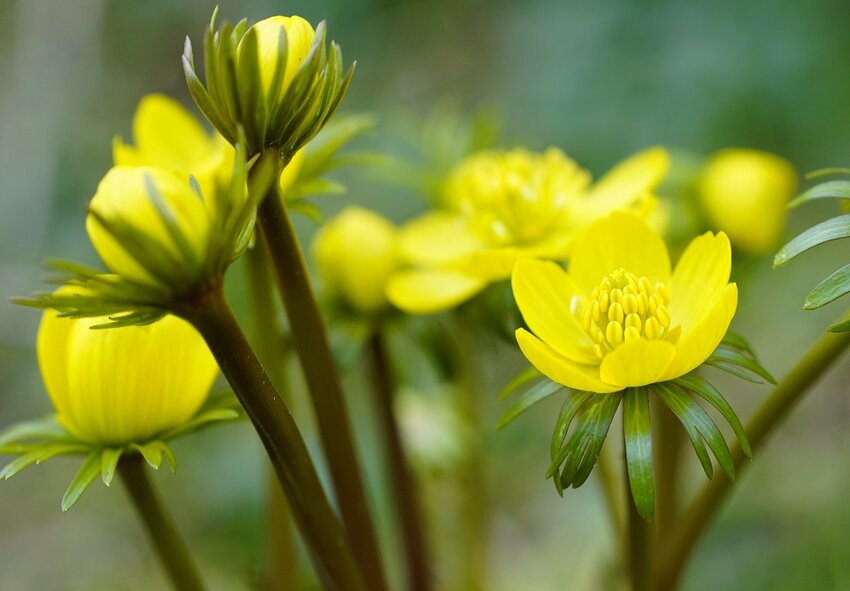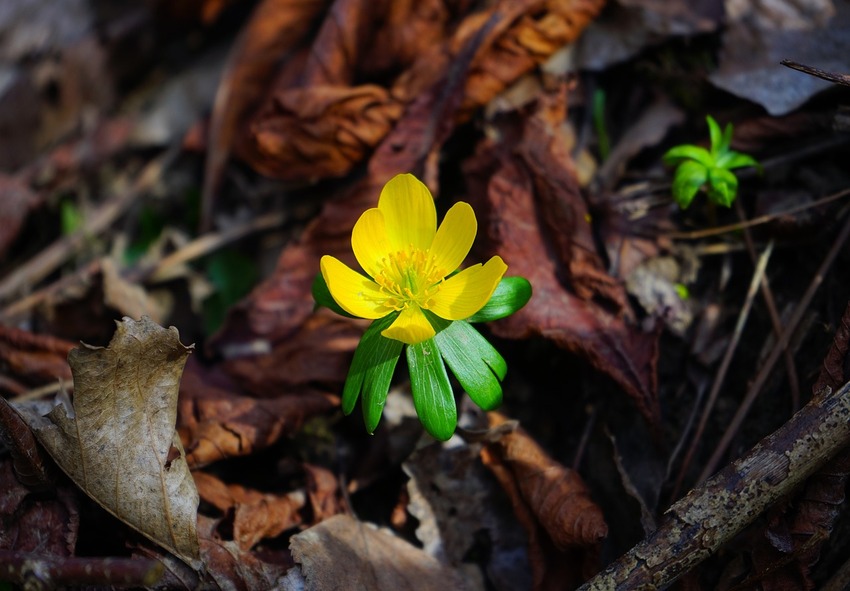Are you interested in adding a bit of sunshine to your living space or outdoor area during the extended winter season? If so, then you should consider Eranthis hyemalis, commonly referred to as Winter Aconite. This dainty and petite plant blooms with remarkable yellow flowers in the beginning of spring, making it an ideal choice for enhancing the beauty of both indoor and outdoor environments. In this piece, we will delve into the advantages of cultivating Eranthis, depict its physical characteristics, and offer guidance on effectively planting and tending to this exquisite blossom.
Understanding Eranthis Growth and Habitat

Eranthis is naturally found in both Europe and Asia and has a maximum height of 6 inches when fully mature. It thrives best in areas that offer partial or full shade, along with soil that is moist and drains well. The bulbs of Eranthis are compact and spherical, with a brownish hue, providing a robust foundation. The plant’s foliage, reminiscent of ferns, exhibits a charming green color, bringing an elegant and gentle presence to both gardens and indoor spaces.
Selecting the Ideal Planting Time for Eranthis
For optimal results, it is recommended to plant Eranthis bulbs during the autumn season, specifically between the months of September and November. This timing allows the bulbs to establish their roots prior to the arrival of winter frost, setting the stage for a beautiful bloom in early spring. Planting during the fall also grants the plant ample time to grow and cultivate a robust root system, which proves essential for withstanding the challenges of the hot summer months.
Assessing Soil Conditions for Eranthis
Eranthis thrives in moist, well-draining soil. Before planting, make sure the soil is rich in organic matter and not compacted. If the soil is heavy and clay-like, add sand or compost to improve drainage. When planting the bulbs, make sure to plant them pointy side up, 2-3 inches deep in the soil. Water the bulbs thoroughly after planting to help them establish roots.
Step-by-Step Guide for Planting Eranthis Bulbs

Planting eranthis bulbs, also known as winter aconite, can be a delightful way to bring early spring color to your garden. Here’s a step-by-step guide to help you plant eranthis bulbs successfully:
- Choose the right time: Eranthis bulbs are typically planted in the fall, around September to October. This allows them to establish their roots before winter and bloom in early spring.
- Select a suitable location: Eranthis bulbs prefer partial shade to full shade. Look for an area in your garden that receives dappled sunlight or is shaded by trees or shrubs. The soil should be well-draining and rich in organic matter.
- Prepare the soil: Before planting, prepare the soil by removing any weeds, rocks, or debris. Loosen the soil to a depth of about 6 to 8 inches (15-20 cm) using a garden fork or spade. Incorporate organic matter, such as compost or well-rotted manure, to improve soil fertility and drainage.
- Dig the planting holes: Dig small holes for each bulb, spaced about 2 to 3 inches (5-8 cm) apart. The depth of the hole should be about 2 to 3 inches (5-8 cm) as well. If you’re planting multiple bulbs, you can dig a larger hole and place them together.
- Place the bulbs: Gently place each Eranthis bulb in the hole with the pointed end facing upwards. Ensure that the bulbs are not touching each other or the sides of the hole.
- Cover and backfill: Carefully backfill the holes with soil, covering the bulbs completely. Lightly press the soil down to remove any air pockets, but avoid compacting it too much.
- Water thoroughly: After planting, water the area thoroughly to help settle the soil and provide moisture to the bulbs. Ensure that the soil is evenly moist, but not overly saturated, as this can cause bulb rot.
- Mulch the area: Apply a layer of mulch, such as shredded bark or straw, around the planted bulbs. This will help conserve moisture, suppress weed growth, and provide insulation during the winter.
Remember, Eranthis bulbs are perennial plants, so with proper care, they should come back year after year, gradually forming larger clumps and providing more blooms.
Essential Care Practices for Eranthis

Once planted, Eranthis requires minimal care. Keep the soil moist but not waterlogged, and fertilize with a balanced fertilizer in early spring. Deadhead spent flowers to encourage new growth. If you live in an area with harsh winters, it’s a good idea to cover the plant with mulch or leaves to protect it from frost.
Encouraging Eranthis Blooming and Naturalization
Eranthis can naturalize and spread easily. To encourage this, leave the foliage intact after blooming and allow it to die back naturally. This will help the plant store energy for the following year’s growth. As the plant matures, it will produce more and more flowers, creating a stunning display in your garden or indoor space.
Addressing Common Eranthis Challenges
Eranthis is generally a hardy plant, but can be susceptible to pests such as slugs and snails. To prevent this, use organic slug pellets or copper tape around the planting area. Eranthis can also be affected by fungal diseases such as gray mold and root rot. To prevent this, ensure proper drainage and avoid overwatering. If you notice any signs of disease or pest infestation, treat the plant with an appropriate pesticide or fungicide.
In conclusion, Eranthis hyemalis is a beautiful and easy-to-care-for plant that brings a touch of early spring to any garden or home. By following our step-by-step guide and essential care practices, you can successfully plant and enjoy the benefits of this stunning flower. Don’t hesitate to buy Winter Aconite bulbs and add a splash of sunshine to your life!
Frequently Asked Questions (FAQs) about Eranthis
1. What are Eranthis flowers, and why should I consider planting them in my garden?
Eranthis, commonly known as Winter Aconite, are small, delightful spring-blooming flowers that often emerge as early as late winter. They are prized for their bright yellow cup-shaped blossoms, which are a welcome sight after a long, cold winter. Planting Eranthis in your garden not only adds vibrant color but also provides essential nectar for early pollinators like bees. These hardy perennial plants are relatively low-maintenance, making them an excellent addition to any garden.
2. When is the best time to plant Eranthis bulbs?
The ideal time to plant Eranthis bulbs is in the fall, typically between September and November, before the ground freezes. This allows the bulbs to establish their roots before the cold weather sets in and ensures they’ll burst into bloom as early as late winter or early spring.
3. Can I order Holland Eranthis bulbs from your online store?
Yes, you can order Eranthis bulbs from our online store. We offer a selection of Eranthis varieties to help you embrace the early bloomers in your garden. Our bulbs are carefully sourced to ensure quality and are shipped at the right time for planting in your region. Feel free to browse our catalog to discover the beauty of Eranthis and start your journey to mastering the art of planting these charming winter aconites.
4. How do I care for Eranthis plants once they are established?
Eranthis plants are relatively low-maintenance. Ensure they receive well-drained soil and partial to full shade. Once they’re established, they will naturalize and multiply over the years. Keep the soil consistently moist during their growing season, and you can also apply a balanced, slow-release fertilizer in early spring. After blooming, allow the foliage to die back naturally, as it provides energy for next year’s growth. Over time, you’ll enjoy a beautiful carpet of Eranthis in your garden.
5. Are Eranthis plants deer-resistant?
Eranthis plants are generally considered deer-resistant due to their toxic properties, which make them unappetizing to most wildlife, including deer. However, in times of extreme hunger, some deer may nibble on them. To provide extra protection, consider using deer repellent measures in your garden if deer are a concern in your area.
Published: 12.06.2023
